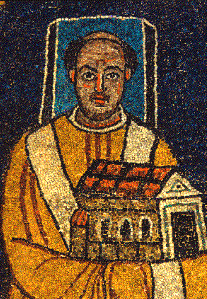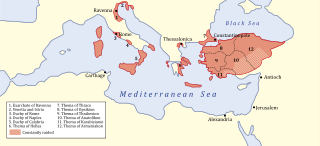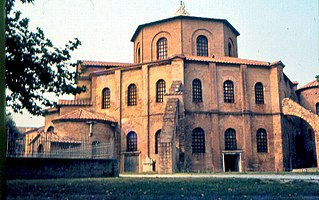Related Research Articles

The Liber Pontificalis is a book of biographies of popes from Saint Peter until the 15th century. The original publication of the Liber Pontificalis stopped with Pope Adrian II (867–872) or Pope Stephen V (885–891), but it was later supplemented in a different style until Pope Eugene IV (1431–1447) and then Pope Pius II (1458–1464). Although quoted virtually uncritically from the 8th to 18th centuries, the Liber Pontificalis has undergone intense modern scholarly scrutiny. The work of the French priest Louis Duchesne, and of others has highlighted some of the underlying redactional motivations of different sections, though such interests are so disparate and varied as to render improbable one popularizer's claim that it is an "unofficial instrument of pontifical propaganda."
Pope Sergius I was the bishop of Rome from 15 December 687 to his death, and is revered as a saint by the Roman Catholic church. He was elected at a time when two rivals, Paschal and Theodore, were locked in dispute about which of them should become pope. His papacy was dominated by his response to the Quinisext Council, the canons of which he steadfastly refused to accept. Thereupon Emperor Justinian II ordered Sergius' arrest, but the Roman people and the Italian militia of the exarch of Ravenna refused to allow the exarch to bring Sergius to Constantinople.
Pope Sergius II was the bishop of Rome and ruler of the Papal States from January 844 to his death in 847. Sergius II's pontificate saw the Arab raid against Rome as well as the city's redevelopment.
Pope Valentine was the bishop of Rome and ruler of the Papal States for two months in 827. He was unusually close to his predecessor, Eugene II, rumoured to be his son or his lover, and became pope before being ordained as a priest. He was a nobleman and elected by nobility, which later became the custom.

Pope Paschal I was the bishop of Rome and ruler of the Papal States from 25 January 817 to his death in 824.
Pope Theodore I was the bishop of Rome from 24 November 642 to his death. His pontificate was dominated by the struggle with Monothelitism.
Pope Severinus was the bishop of Rome elected in October 638. He was caught up in a power struggle with Emperor Heraclius, who pressured him to accept Monothelitism. Severinus refused, which for over eighteen months hindered his efforts to obtain imperial recognition of his election. His pontificate was finally sanctioned on 28 May 640, but he died two months later.
Pope John V was the Bishop of Rome from 23 July 685 to his death. He was the first pope of the Byzantine Papacy consecrated without prior imperial consent, and the first in a line of ten consecutive popes of Eastern origin. His papacy was marked by reconciliation between the city of Rome and the Empire.
Pope Conon was the bishop of Rome from 21 October 686 to his death. He had been put forward as a compromise candidate, there being a conflict between the two factions resident in Rome— the military and the clerical. He consecrated the Irish missionary St Kilian and commissioned him to preach in Franconia.
Sylvester IV, born Maginulf, was a claimant to the Papacy from 1105 to 1111 in opposition to Paschal II. A priest before his election, he was probably a native of Rome. He had the backing of the Roman militia and initially of the Holy Roman Emperor, Henry IV, who later forced him to abdicate. Today he is regarded as an antipope.
Paschal was a rival with Theodore for Pope following the death of Pope Conon, and thus is considered an antipope of the Roman Catholic church.
Antipope John VIII or Antipope John was an antipope of the Roman Catholic church, in the year 844. On the death of Pope Gregory IV, the populace of Rome declared John, a deacon with no known links to the aristocracy as his successor. They seized the Lateran Palace and enthroned him there. However, the lay aristocracy elected as pope the elderly, nobly born archpriest Sergius, ejected John from the Lateran, and swiftly crushed the opposition. Pope Sergius II's consecration was rushed through immediately, without waiting for imperial ratification from the Frankish court. Although some of his supporters wanted John put to death for what they considered his presumption, Sergius intervened to save his life and John was confined to a monastery. Nothing further is known about him.
John Platyn or Platinus was an Exarch of Ravenna.
John III Rizocopus was an Exarch of Ravenna (710).

Isaac the Armenian was an exarch of Ravenna hailing from the Kamsarakan clan. The chronology of the Exarchate in this period is uncertain: either he succeeded Euselnus and served c. 625 – 644; or he succeeded Eleutherius, and served 620 – 637.

The Duchy of Rome was a state within the Byzantine Exarchate of Ravenna. Like other Byzantine states in Italy, it was ruled by an imperial functionary with the title dux. The duchy often came into conflict with the Papacy over supremacy within Rome. After the founding of the Papal States in 756, the Duchy of Rome ceased being an administrative unit and 'dukes of Rome', appointed by the popes rather than emperors, are only rarely attested.
Toto was the self-styled duke of Nepi, the leading magnate of Etruria, who staged a coup d'état in Rome in 767. He became Duke of Rome for a year until his death. The principal sources documenting his takeover are the vita of Pope Stephen III in the Liber Pontificalis and a surviving deposition of the primicerius Christopher from 769, preserved in a ninth-century manuscript of Verona, the Depositio Christophori.

The Byzantine Papacy was a period of Byzantine domination of the Roman papacy from 537 to 752, when popes required the approval of the Byzantine Emperor for episcopal consecration, and many popes were chosen from the apocrisiarii or the inhabitants of Byzantine-ruled Greece, Syria, or Sicily. Justinian I conquered the Italian peninsula in the Gothic War (535–554) and appointed the next three popes, a practice that would be continued by his successors and later be delegated to the Exarchate of Ravenna.

The Lateran Council of 769 was a synod held in the Basilica of St. John Lateran to rectify perceived abuses in the papal electoral process which had led to the elevation of the antipopes Constantine II and Philip. It also condemned the rulings of the Council of Hieria. It is perhaps the most important Roman council held during the 8th century.
References
- ↑ The Book of Pontiffs (Liber Pontificalis) . Translated by Davis, Raymond (first ed.). Liverpool: University Press. 1989. p. 83. ISBN 9780853232162.
- ↑ Ekonomou, Andrew J. (2007). Byzantine Rome and the Greek Popes: Eastern influences on Rome and the papacy from Gregory the Great to Zacharias, A.D. 590–752. New York: Lexington Books. p. 216. ISBN 978-0-7391-1977-8.